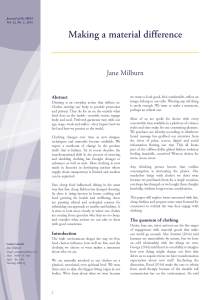 Dressing is an everyday action that defines us. Clothes envelop our body to provide protection and privacy. They do for us on the outside what food does on the inside—nourish, warm, engage body and soul. Preferred garments vary with our age, stage, work and wallet—they impact how we feel and how we present to the world.
Dressing is an everyday action that defines us. Clothes envelop our body to provide protection and privacy. They do for us on the outside what food does on the inside—nourish, warm, engage body and soul. Preferred garments vary with our age, stage, work and wallet—they impact how we feel and how we present to the world.
Clothing changes over time as new designs, techniques and materials become available. We expect a modicum of change in the product itself: that is fashion. Yet in recent decades, the transformational shift in the process of sourcing and shedding clothing has brought changes to substance as well as style.
Most clothing is now made in factories in developing nations where supply chain transparency is limited and workers can be exploited. Fast, cheap food influenced dining in the same way that fast, cheap fashion has changed dressing. As there is rising interest in home cooking and food growing for health and wellbeing, there are pressing ethical and ecological reasons for rethinking our approach to textiles and fashion. It is time to look more closely at where our clothes are coming from, question why they are so cheap, and consider what actions we can take to dress with good conscience. Read more in the Journal of the Home Economics Institute of Australia Journal Vol. 22, No. 1, 2015 Milburn, Jane FINAL Making a material difference